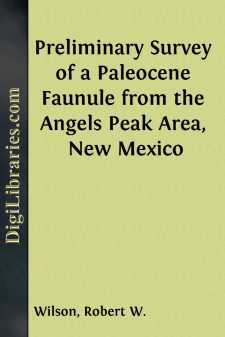Categories
- Antiques & Collectibles 13
- Architecture 36
- Art 48
- Bibles 22
- Biography & Autobiography 813
- Body, Mind & Spirit 142
- Business & Economics 28
- Children's Books 14
- Children's Fiction 11
- Computers 4
- Cooking 94
- Crafts & Hobbies 4
- Drama 346
- Education 46
- Family & Relationships 57
- Fiction 11828
- Games 19
- Gardening 17
- Health & Fitness 34
- History 1377
- House & Home 1
- Humor 147
- Juvenile Fiction 1873
- Juvenile Nonfiction 202
- Language Arts & Disciplines 88
- Law 16
- Literary Collections 686
- Literary Criticism 179
- Mathematics 13
- Medical 41
- Music 40
- Nature 179
- Non-Classifiable 1768
- Performing Arts 7
- Periodicals 1453
- Philosophy 64
- Photography 2
- Poetry 896
- Political Science 203
- Psychology 42
- Reference 154
- Religion 513
- Science 126
- Self-Help 84
- Social Science 81
- Sports & Recreation 34
- Study Aids 3
- Technology & Engineering 59
- Transportation 23
- Travel 463
- True Crime 29
Preliminary Survey of a Paleocene Faunule from the Angels Peak Area, New Mexico
by: Robert W. Wilson
Description:
Excerpt
INTRODUCTION
Angels Peak stands on the eastern rim of a large area of badlands carved by a tributary of the San Juan River from Paleocene strata of the Nacimiento formation, and presumably also from Wasatchian strata of the San José (Simpson, 1948). This area of badlands lies some twelve miles south of Bloomfield, New Mexico in the Kutz Canyon drainage. Angels Peak (Angel Peak of Granger, 1917) and Kutz Canyon (Coots Cañon of Granger, and of Matthew, 1937) are names that have been applied to the location (figure 1).
Figure 1. Map of a part of the San Juan Basin, New Mexico, showing location of University of Kansas fossil locality west of Angels Peak.
E. D. Cope's collector, David Baldwin, possibly worked in this area in the Eighties. The first published record, however, of mammalian fossils from the Angels Peak badlands was made by Walter Granger in 1917 as a result of his field work in the preceding summer. Granger obtained specimens, usually poorly preserved, but occasionally rather abundant locally, from various levels up to within 150 feet of the western rim of the badlands basin. This collection was obviously of Torrejonian or middle Paleocene age. In the 1917 report, Granger gave as a faunal list the following species:
Tetraclaenodon
Mioclaenus turgidus
Periptychus rhabdodon
Anisonchus sectorius
Protogonodon sp. nov.
Tricentes
Deltatherium
Psittacotherium
To this list should be added Triisodon antiquus, a specimen of which is stated by Matthew to come from Kutz Canyon in his monograph (1937:80) on the Paleocene faunas of the San Juan Basin.
In the summer of 1948, a field party from the University of Kansas was fortunate in finding a local concentration of rather well preserved material at the western edge of the badlands at Angels Peak. Because it probably will be some time before a full account of this faunule can be prepared, it is thought advisable, preliminarily, to give a general statement as to occurrence, and tentatively to list the species.
The mammalian fossils, numbering approximately 150 specimens, were all obtained within a small area located in the NW 1/4 of sec. 14, T. 27 N, R. 11 W, San Juan County, New Mexico. The specimens were collected from a zone of reddish silt three to four feet in thickness. The actual bone layer, not as yet located, may prove to be thinner than this. Almost all the material was recovered from approximately 100 linear yards of outcrop. A few specimens, however, were obtained at varying distances away from this central area, as far distant perhaps as one-half mile. Of these, nineteen were at the same level stratigraphically, and only one was lower (by 70 feet) in the section. This latter specimen, representing a new genus and species of Primates, is not certainly duplicated by material at the main concentration. Seemingly, the others are.
The red zone at the "bone pocket" carries many concretionary masses which frequently contain the fossil specimens. Not all specimens, however, are from such lumps....


